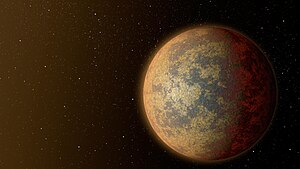HD 219134 b
| Exoplanet | List of exoplanets | |
|---|---|---|
 |
||
| Parent star | ||
| Star | HR 8832 | |
| Constellation | Cassiopeia | |
| Right ascension | (α) | 23h 13m 16.9763s |
| Declination | (δ) | +57° 10′ 06.082″ |
| Apparent magnitude | (mV) | 5.574 |
| Distance | 21.25 ly (6.52 pc) |
|
| Spectral type | K3V | |
| Mass | (m) |
0.794+0.037 −0.022 M☉ |
| Radius | (r) | 0.80 (± 0.04) R☉ |
| Temperature | (T) | 4710 K |
| Metallicity | [Fe/H] | +0.20 |
| Age | ~12.46 Gyr | |
| Orbital elements | ||
| Semi-major axis | (a) | 0.0382 (± 0.0003)AU |
| Eccentricity | (e) | 0.00+0.13 −0.0 |
| Orbital period | (P) | 3.0937 (± 0.0004)d |
| Inclination | (i) | 85.058 ± 0.08° |
| Physical characteristics | ||
| Mass | (m) | 4.47 (± 0.47)M⊕ |
| Radius | (r) | 1.606 (± 0.086)R⊕ |
| Density | (ρ) | 5.89 (± 1.17)g cm−3 |
| Temperature | (T) | 800 K (527 °C; 980 °F) K |
| Discovery information | ||
| Discovery date | 30 July 2015 | |
| Discoverer(s) | ||
| Discovery method | radial velocity method (HARPS-N) | |
| Other detection methods | transiting (Spitzer telescope) | |
| Discovery site | HARPS-N of the Telescopio Nazionale Galileo | |
| Discovery status | Published | |
| Database references | ||
| Extrasolar Planets Encyclopaedia |
data | |
| SIMBAD | data | |
| Exoplanet Archive | data | |
| Open Exoplanet Catalogue | data | |
HD 219134 b (or HR 8832 b) is one of seven exoplanets orbiting HR 8832, a main-sequence star in the constellation of Cassiopeia. As of July 2015, super-Earth HD 219134 b, with a size of about 1.6 Earth Radii, and a density of 6g/cm3, was reported as the closest rocky exoplanet to the Earth, at 21.25 light-years away. The exoplanet was initially detected by the instrument HARPS-N of the Italian Telescopio Nazionale Galileo via the radial velocity method and subsequently observed by the Spitzer telescope as transiting in front of its star. The exoplanet has a mass of about 4.5 times that of Earth and orbits its host star every three days.
HD 219134 b is a super-Earth, an exoplanet with a radius and mass bigger than Earth, but smaller than that of the ice giants Neptune and Uranus. Its surface temperature is around 800 K (527 °C; 980 °F). It has a radius of 1.6 R⊕ and a mass of around 4.5 M⊕.
The planet orbits a (K-type) star named HR 8832, orbited by a total of seven planets. The star has a mass of 0.79 M☉ and a radius of 0.80 R☉. It has a temperature of 4710 K and is about 12.5 billion years old, making it one of the oldest stars. In comparison, the Sun is 4.6 billion years old and has a temperature of 5778 K.
The star's apparent magnitude, or how bright it appears from Earth's perspective, is 5. It can be seen with the naked eye.
...
Wikipedia
